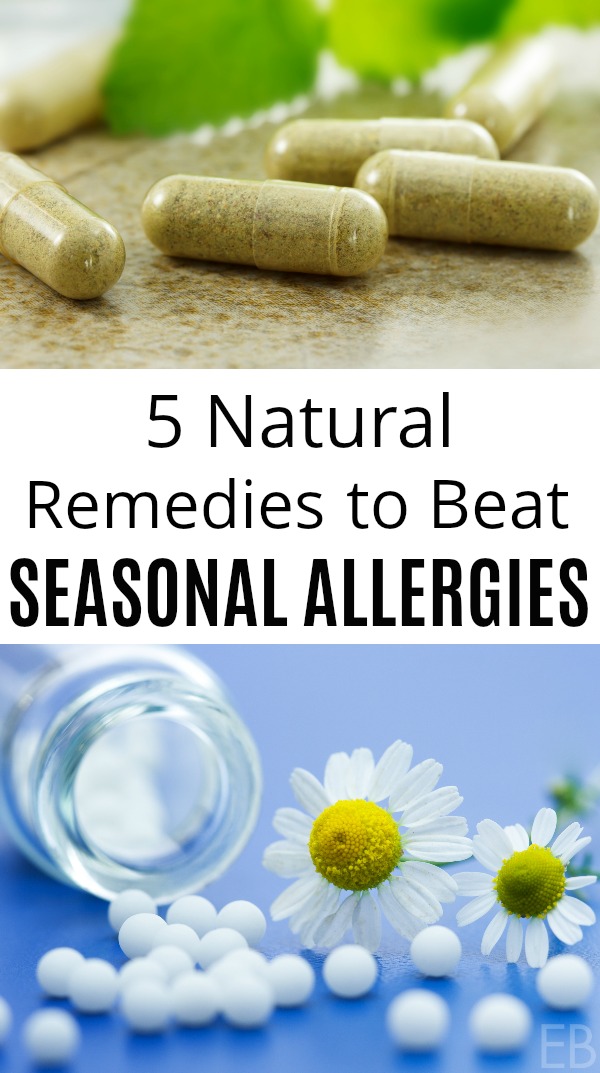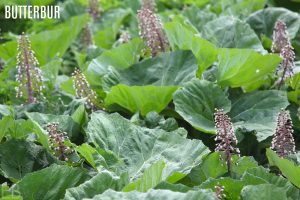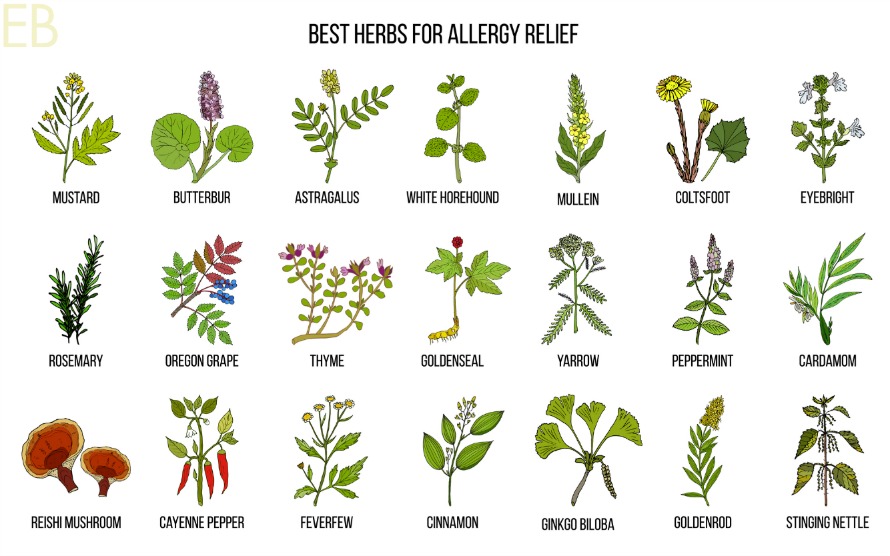I may receive a commission if you purchase through links in this post. I am not a doctor; please consult your practitioner before changing your supplement or healthcare regimen.
Have you started blowing your nose yet? Rubbing your eyes? More than 35 million people in the United States are affected by allergic rhinitis, the body’s release of histamines, and the subsequent inflammation in the lining of the nose, in response to pollen, pet dander, mold spores, and dust mites. With the rain, spring flowers, and wind blowing in, so too is hay fever. If you struggle with allergies each year, this post is for you — and the sniffling kids in your life too. Learn 5 natural remedies to beat seasonal allergies!

Homeopathics and Herbs
While Western medicine is based on the principle of contrary curing contrary, as in fighting histamines with antihistamines, naturopathy and homeopathy are based on the principle of like cures like.
Herbs and homeopathy have been looked to increasingly over that last 20 years as patients have become interested in the natural wisdom of the past and disenchanted with the cost and side effects associated with pharmaceuticals.
This post shares with you both homeopathic and herbal remedies.
Here are 5 tried and true remedies that may provide relief when nothing else has.
Ambrosia
Yes, it’s a strange Southern dessert, but it’s also a homeopathic: ambrosia. And it’s one with a great track record. Many testify to the effectiveness of this remedy, both for adults and kids. Here’s the one recommended by our doctor. Ambrosia is the homeopathic dose of ragweed. It may also help asthma induced by allergens and throat irritation, as well as stuffy nose and head. Some find this remedy to be more effective in fall. If one of the 50 species of ragweed grows in your area in spring, it’s recommended.
Natrum Muriaticum
This remedy has helped our daughter in the past and is excellent for those with recurrent spring and fall allergies, especially those that are worse in the morning, and for those who cough up lots of mucous. (Side note — this remedy also works really well for run of the mill headaches [not migraines]. It literally has made every headache on which I’ve used it go away! It can be used like Advil, upon need. I use 4 pellets under my tongue and keep it close at hand for the unexpected times it’s needed.)

Butterbur
Butterbur is a large-leaved shrub that grows in North America, Asia and parts of Europe. Traditionally its large leaves were wrapped around butter to keep it cool in warm weather, thus its name. Butterbur was also used traditionally to treat wounds, coughs, fever, headaches, anxiety, gastrointestinal and urinary tract conditions. The leaves, roots and rhizomes are all used to formulate butterbur supplements.
formulate butterbur supplements.
Used most commonly for common headaches, migraines, and seasonal allergies, the bitter tasting compound found within butterbur, called Petasin, alleviates symptoms for many. Recommended by the British Medical Journal, butterbur can be used up to 4 times daily to keep allergy symptoms at bay. Many find relief with just 75 mg. daily, starting early spring so it can build up in one’s system. Consult your doctor for the dosage right for you. (Allergy note: Butterbur is in the daisy family and related to Ragweed; so you may need to avoid it if you’re allergic to Ragweed. Use of butterbur with children should be done under the care of a practitioner.)
Nettles
Yep, had to include this one! Nettles, specifically Stinging Nettles, prevent the release of pro-inflammatory mediators; they reduce the amount of histamines the body produces in response to allergens. Nettles may also interfere with the way the body sends messages of pain. Nettles have been tested and studied extensively, used to treat prostate conditions, Alzheimer’s disease, arthritis, bronchitis, laryngitis, hives, bladder infections and many more conditions; it’s an herb that’s advocated for by both naturopathic and medical practitioners. We even see it being used for chronic inflammation, conditions such as sciatica, tendinitis, and rheumatoid arthritis.
Nettles is an herb that may work best when used early in the allergy season, so it can build up in the body before allergens are at their worst. Patients on blood thinners or blood pressure medication should consult their practitioner before using nettles.
Nettles are safe and recommended for children. Combined with quercetin, also recommended and next up, you may find the relief many have.
Quercetin
Another great basic! If you haven’t used this in the past, you may want to try Ambrosia homeopathic first and then add the quercetin if needed. Quercetin is an anti-inflammatory flavonol found in many vegetables, fruits and other plant foods. It works by preventing immune cells from releasing histamines. Studied extensively, quercetin has shown itself to have strong antioxidant and anti-inflammatory properties. It’s been used to treat high blood pressure, interstitial cystitis, prostate inflammation, and to help prevent colon cancer. It has even shown itself to increase oxygen utilization and endurance in athletes, and to help with asthma. Quercetin is considered safe for children.
The capsule links below combine nettles and quercetin. They work well together and prevent the need to buy and try two different remedies. For serious allergies, patients may need to take the remedy throughout the day, 2 capsules up to 4 times daily. 500 mg. of quercetin taken twice daily is a commonly recommended adult dosage. Consult a practitioner for the dosage right for you. I recommend these brands: 1, 2, and 3
What about diet?
It’s true: Giving up certain foods is often the key to relief. For my daughter, giving up dairy meant she could run around outside freely, during allergy season. Previously she had had to stay indoors or go out with a mask while the grasses bloomed — for 6 weeks! She had already given up grains and sugar.
Many find that eliminating foods is the most important step to allergy relief. For some that may mean adopting a Traditional diet: one with fermented foods, predigested grains, bone broth and an absence of processed foods, including refined sugars. For others the Paleo diet might be necessary and helpful: grain-free, refined sugar-free, processed foods-free.
Consider which foods allow your body to flourish and to heal itself. Whole food diets, or diets with allergy foods removed, take into account digestion. This approach offers freedom and a different kind of pleasure than standard American diet foods or foods you may love that are causing an allergic response.

I’d love to hear your experiences with seasonal allergies and natural remedies. Share your comments or questions below. 🙂
SOURCES

Renee Kohley says
This is really interesting! I have not heard of some of these. We harvest stinging nettles though every spring – they are starting to pop up right now. 2 of my girls get really watery eyes when our huge maple trees bloom – it never fails. But they used to be terrible all spring and fall – with some diet changes and the nettles they are just a little watery during that tree blooming!
Megan Stevens says
Yay, that’s a great improvement and commentary on the healing power of diet and herbs!!
harmonyrestored says
Wonderful remedies. A few of these we haven’t tried yet. Thank you so much for sharing!
Megan Stevens says
You’re welcome.
linda spiker says
Great post! Since starting Whole 30 in January my husband has not had his usual seasonal allergies. No need to pop Claritin.
Megan Stevens says
Yay!!! Love that!! Diet is so amazing!!
Marjorieann1977 says
Great post. I knew about nettles, but the others are new to me. I have this pinned to help my husband with his allergies.
Megan Stevens says
Great. I’m so glad.
Emily @ Recipes to Nourish says
This is so helpful Megan. I didn’t really know about most of these except for nettles. I really love that you address diet in here too, because that can often be a key component or at least help ease the symptoms.
Megan Stevens says
Totally. 🙂 Thanks!
Andrea Kessel Fabry says
I’m so glad to know about butterbur! We use nettle and quercetin quite a bit. Great to know about other options. Sometimes it’s a combination of remedies that does the trick!
Megan Stevens says
That’s so true! I hope it helps.
Carol @studiobotanica says
Good ideas! Truth: Not a lot of healing will happen without lifestyle and diet support!
Wonderful news that elimination of dairy helped your daughter in such a powerful way.
With clients, I start with the big players first: Gluten, Dairy, Soy, Corn and Sugar.
btw Nettle Seed is what we use to help with prostate function.
Also ~ FYI GoldenRod is also a wonderful anti-allergenic herb. I use nettle leaf in early Spring and GoldenRod mid summer in preparation for autumn ‘season’.
Megan Stevens says
Thanks for sharing, Carol!!
Carol @studiobotanica says
You always share from your heart with such valuable information! Thank you.
Lindsey Dietz says
I was not aware of that homeopathic remedy! Thankfully, we don’t struggle with seasonal allergies, but it’s always nice to have something on hand that works well on headaches!
Megan Stevens says
Seriously! Headaches can be such an enigma. I hope you get and see relief from the Nat. Mur.!
Anna @GreenTalk says
When my son gave up gluten, his allergy symptoms were far less. Growing nettle for the first time this year. I am glad Carol mentioned goldenrod. It gets such a bad rap since people think it looks like ragweed. Mine blooms in Sept and October.
Megan Stevens says
Thanks, Anna, for adding your insights and experience!
Angie Rico Syacsure says
How do you use the nettle? Do you use it as a tea or eat it? Sorry but I’m am suffering right now and need to do something today. I thought my diet had worked and I was past this but I’m not.
PS I Enjoyed stopping at your cafe in late January and loved the coffee and soup. (I was traveling from WA to TX)
Megan Stevens says
Hi Andrea, I’m sorry for your discomfort! Nettles is one remedy that is best built up in the system. So it will not likely give relief on demand.
(I’m so glad you were able to stop in the cafe and that you enjoyed it!) 🙂
Susannah says
Nettle has helped my husband quite a bit. Will consider some of these other options as well, thanks!
Hafiz says
Quercetin is essential for me combined with bromelain feels like a good fit. Making a qt. of nettle tea can be helpful or eating nettles if u can get some.
Thanks for the help and reminders. Happy Spring!
Adrienne says
I just started dabbling again in homeopathy. Not sure if it really is working for us but I’m excited to try these! We did get new air filters in our home that have made a HUGE difference!
linda spiker says
I haven’t tried any of these. My husband has seasonal allergies. I will pass this along to him. Our Molekule works wonders but when we leave the house his allergies kick in!
Steven Jonas says
My wife and I have harvesting nettles in the wild the past five years and make a large batch of tincture each spring. This year was a late year as I harvested on April 7, usually it is in mid March for here in the Willamette Valley of Oregon. We start taking the nettle tincture on March 1 to help with our pollen allergies from trees and grass. It works wonderfully well and we don’t need to take any other medications for it as we did before starting it. We also take a quersetin and bromelain capsule each day. Thanks for the article Megan!
Megan says
How wonderful, Steve! Thank you for sharing the details of your success and wellness. You guys get the double benefit of being in the wild and using its wares. How sweet that nature offers us a solution!
Jean says
Coming at a perfect time! Can’t wait to try some of these methods.
Raia Todd says
Definitely nettles, quercetin, and diet! I’ve also found high doses of pure vitamin C are helpful for me. And drinking lots of water.
Deborah says
I have not heard of natrum muriaticum. Would this be acceptable for someone on a low sodium diet? Thank you!
Megan says
Yes, these are little homeopathic pellets, completely acceptable for low sodium. 🙂